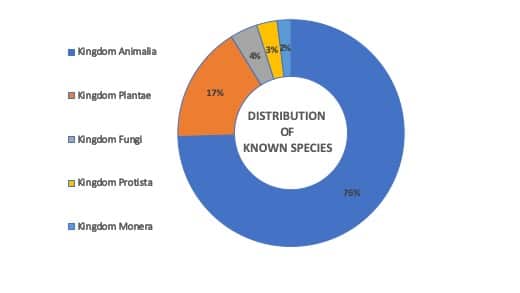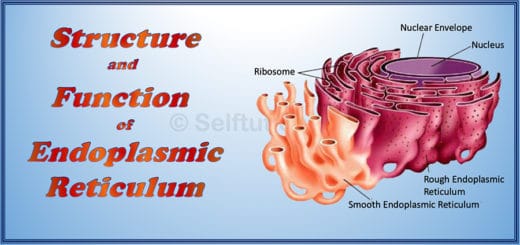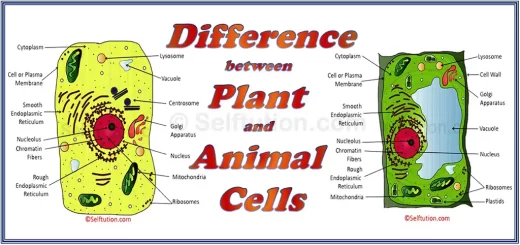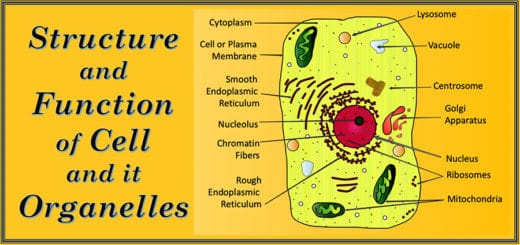Classification of Animal Kingdom, Characteristics & Examples
The classification of the animal kingdom, or the Kingdom Animalia, based on characteristics, along with examples, is as follows:
- Vertebrates – animals with a backbone and skeletal system
- Invertebrates – animals without a backbone
- Porifera (Porous animals) – Sponges and Sycon
- Coelenterate or Cnidarians (Hollow sac animals) – Hydra and Sea Anemone
- Helminths (Flatworms and Roundworms) – Tapeworm and Ascaris
- Annelida (Segmented worms) – Earthworms, and Leech
- Arthropoda (Joint-footed animals) – Butterfly, Cockroach, and Scorpion
- Mollusca (Soft-bodied animals) – Snail and Octopus
- Echinodermata (Spiny-skinned animals) – Starfish and Sea Urchin
TOPICS COVERED:
- Introduction
- Common features of animals
- Classification of the Animal Kingdom
- Other Criteria for Classification of the Animal Kingdom
1.0 INTRODUCTION
The Earth is home to an astonishing 8.7 million living organisms. Scientists have studied and classified about 1.3 million species so far. Most of these belong to the Animal Kingdom, or Kingdom Animalia, which comprises 76% of the total species studied. This means nearly 988,000 species of animals have been identified and documented. The diversity within the animal kingdom is immense, ranging from tiny ants to enormous elephants.
Given the vast number and variety of animals, studying each animal individually is impossible. So, to help, all members of the animal kingdom with similar characteristics are clubbed together to form groups. This process is known as the classification of the animal kingdom or the kingdom Animalia. By grouping animals with shared traits, researchers can better understand and study the complex relationships and evolutionary history of different species.
In this post, we will learn about the different bases used for the classification of the animal kingdom, or the kingdom Animalia, along with examples and characteristics of each group.
Back to the top -Kingdom Animalia Classification and Examples
2.0 COMMON FEATURES OF ANIMALS
Before continuing with the classification of the animal kingdom, it is interesting to note that, although all animals have different features, they also share certain common characteristics. For example:
- Animals are heterotrophic, meaning they cannot prepare food and must feed on plants or other animals.
- Most animals move from one place to another, mainly to search for food or shelter. This movement is called locomotion.
3.0 CLASSIFICATION OF THE ANIMAL KINGDOM OR THE KINGDOM ANIMALIA
The classification of the animal kingdom, or kingdom Animalia, is based on the characteristics that animals exhibit. For example, if you pick up a worm, it feels soft because it has no bones. In contrast, a fish or frog feels hard because they have bones, all joined with a backbone to maintain their body shape. Therefore, depending on the presence or absence of a backbone, animals are broadly classified into two groups: invertebrates and vertebrates.
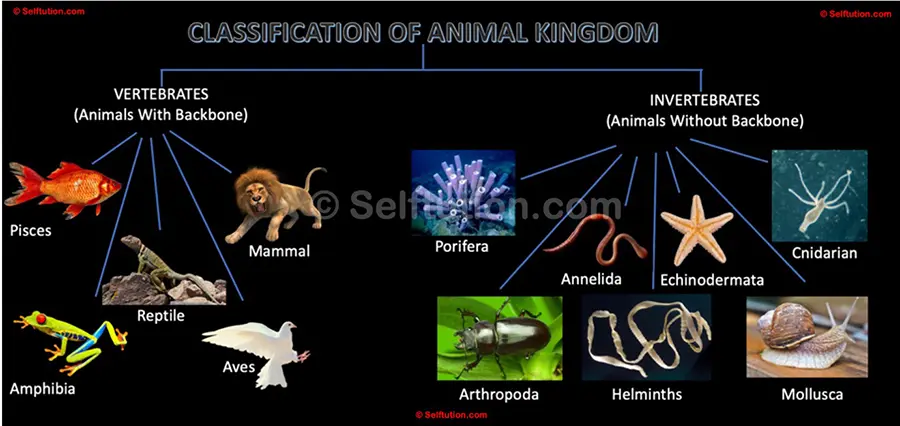
Classification of the Animal Kingdom
The backbone is the long, hard bone starting from below the neck till the end of the back. It consists of small bones called vertebrae. You can feel its presence by running over your back in its center with your hand. The hard structure that you feel is the backbone.Invertebrates are those animals that have no backbone or bony skeleton. Examples of invertebrates are – Amoeba, Euglena, sea anemones, starfish, cockroaches, snails, earthworms, etc. On the other hand, vertebrates are animals that have a backbone or bony skeleton. Examples of vertebrates are – fish, frogs, snakes, lizards, birds, monkeys, cows, cats, elephants, kangaroos, humans, etc.
Likewise, there are also other characteristics that we use for the classification of the animal kingdom. These are:
- Body type – hollow, flat, round, porous, soft, etc..
- The temperature of blood – cold or warm,
- Type of body covering -scaled, segmented, etc..
- Mode of reproduction – laying of eggs, giving birth to the young ones, etc..
- Mode of nutrition – herbivores, carnivores, omnivores, and parasites.
3.1 CLASSIFICATION AND EXAMPLES OF ANIMAL KINGDOM BASED ON THE PRESENCE OF BACKBONE – VERTEBRATES
Vertebrates are animals with a backbone or bony skeleton. Based on their varying characteristics, they are further divided into five groups or classes.
3.1.1 Pisces (Fishes)
Common examples of Pisces: Almost all fishes, and to name a few – Rohu, shark, electric ray fish, etc.
The main characteristics of Pisces (or fishes) are:
Almost all Pisces live in water, whether seawater or freshwater. They possess special characteristics that enable them to thrive underwater. One notable feature is their streamlined body, which is narrow at both ends, along with fins and scales that aid in swimming. Another key adaptation is their gills, specialized organs that allow them to extract oxygen from water. Additionally, Pisces are cold-blooded, a trait essential for underwater survival. Most fish reproduce by laying eggs, ensuring the continuation of their species. These characteristics make Pisces a fascinating and diverse group within the animal kingdom.
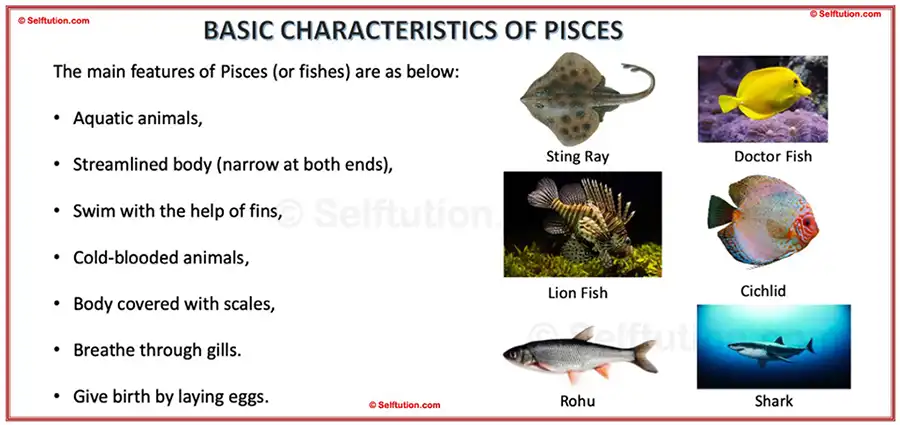
Characteristics of Pisces with examples
Back to the top -Kingdom Animalia Classification and Examples
3.1.2 Amphibia
Common examples of Amphibians are frogs, toads, salamanders, etc.
The main characteristics of Amphibians are as follows:
Amphibians are unique animals capable of living both in water and on land. The characteristics of amphibians enable them to thrive in these dual environments. For instance, they have slimy and slippery skin that serves as a protective barrier, preventing water from penetrating their bodies and helping to keep their skin moist. Another critical characteristic of amphibians is their ability to breathe through both lungs and the pores in their skin, allowing them to obtain oxygen efficiently whether submerged in water or on land.
Amphibians are cold-blooded, meaning their body temperature adjusts with their surroundings, which is crucial for surviving in varying temperatures underwater and on land. They reproduce by laying eggs in water, where their offspring develop before transitioning to land. Amphibians typically have two pairs of legs adapted for both making long jumps and swimming, aiding in their movement between aquatic and terrestrial habitats. These characteristics make amphibians a fascinating group known for their adaptability and diverse lifestyles.
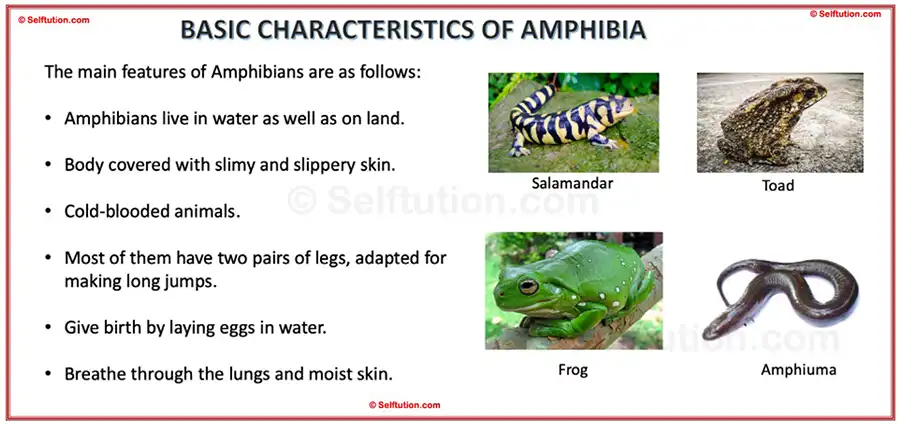
Characteristics and Examples of Amphibians
3.1.3 Reptiles
Common examples of Reptiles are lizards, snakes, turtles, tortoises, crocodiles, etc.
The main features/characteristics of Reptiles are as follows:
Reptiles, derived from the Latin word meaning ‘creeping or crawling animals‘, encompass a diverse group of creatures with distinct characteristics. These characteristics of reptiles include their ability to crawl on land, supported by a backbone, which distinguishes them in the animal kingdom. Most reptiles breathe through lungs and predominantly inhabit land, although some, like crocodiles and turtles, also thrive in water. Their skin is typically dry and covered with scales, providing protection and reducing water loss.
One of the defining characteristics of reptiles is that they typically have four short legs, which facilitate their movement on land. However, snakes, unique among reptiles, lack legs and instead move by slithering with the help of scales. Despite their limbless appearance, snakes are vertebrates, possessing numerous vertebrae that allow for remarkable flexibility. Reptiles reproduce either by laying eggs on land or, in some species, giving birth to live young. These characteristics of reptiles highlight their adaptations to various habitats and their evolutionary diversity within the animal kingdom.
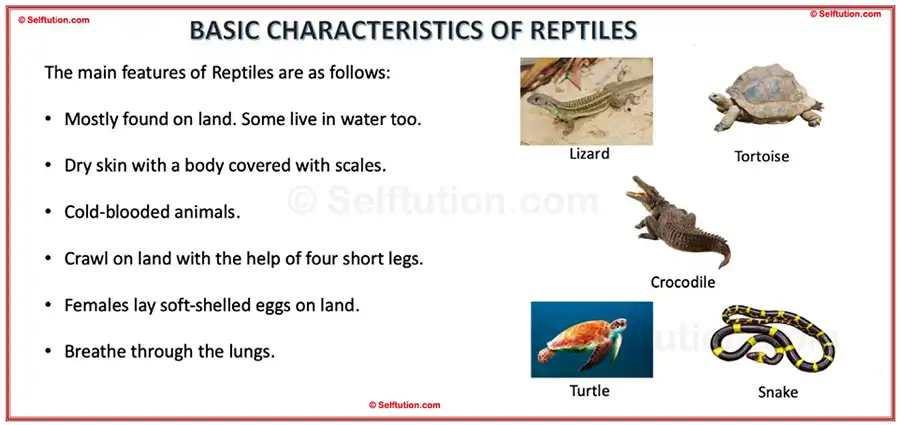
Characteristics and Examples of Reptiles
Back to the top -Kingdom Animalia Classification and Examples
3.1.4 Aves (Birds)
Common examples of Aves: Pigeon, sparrow, parrot, peacock, hen, duck, etc.
The main characteristics of Aves are as follows:
Aves, or birds, possess unique characteristics that set them apart in the animal kingdom. They have streamlined bodies adorned with feathers and are equipped with wings designed for flight. Their bones are notably lightweight and hollow, which enhances their ability to soar through the air efficiently. While many birds are capable of flight, some, such as the ostrich, are flightless but still retain other avian traits.
Birds are warm-blooded animals, sharing this trait with mammals, and they possess scales only on their legs and toes. Their jaws are distinguished by horny beaks adapted for grasping and manipulating food. One of the defining characteristics of aves is their method of reproduction: females lay hard-shelled eggs, a feature common across all bird species. These adaptations reflect the diverse evolutionary paths that birds have taken to thrive in various environments worldwide.
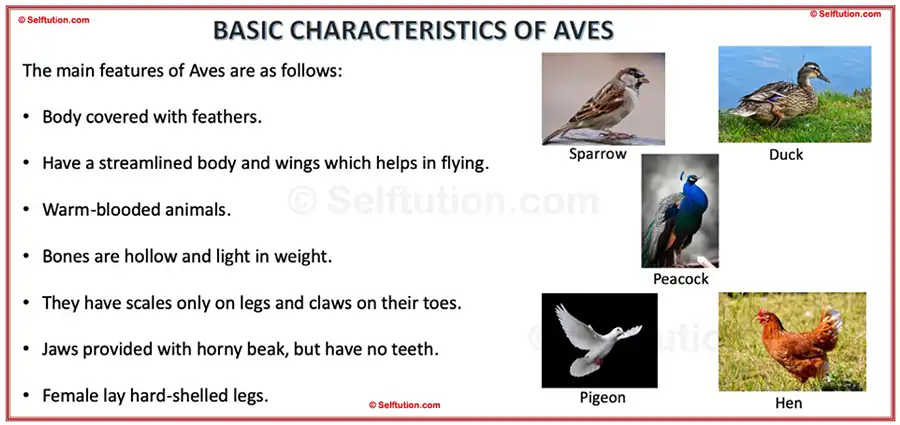
Characteristics and Examples of Aves
Back to the characteristics of amphibians
3.1.5 Mammalia
Common examples of mammals are cows, dogs, deer, camels, lions, elephants, rats, whales, dolphins, humans, etc.
The main characteristics of Mammalia are as follows:
Mammals, including humans, have unique characteristics that distinguish them within the classification of the animal kingdom. One of the most notable characteristics of mammals is that they give birth to young ones (babies) rather than laying eggs. The young ones then suckle milk from mammary glands present in their mothers. All mammals are warm-blooded, allowing them to maintain a constant body temperature regardless of their environment.
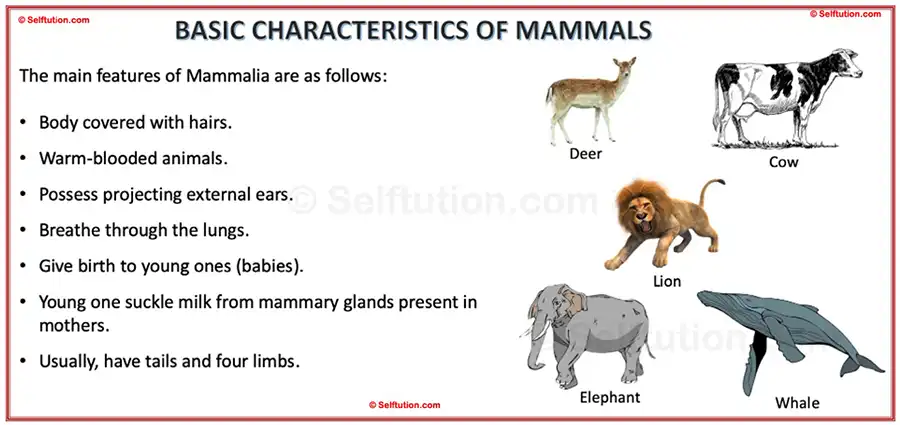
Characteristics and Examples of Mammals
Additionally, mammals breathe through the lungs and possess external ears. Their bodies are typically covered with hair or fur, which provides insulation. Most mammals have tails and four limbs adapted for various activities. The whale, the largest living creature on Earth, is also a mammal. Unlike fish, whales do not lay eggs or breathe through gills; instead, they give birth to live young and breathe through lungs, just like other mammals. These characteristics of mammals highlight their adaptability and distinctiveness within the animal kingdom.
Back to the top -Kingdom Animalia Classification and Examples
3.2 CLASSIFICATION AND EXAMPLES OF ANIMAL KINGDOM BASED ON ABSENCE OF BACKBONE – INVERTEBRATES
Invertebrates are those animals that do not have a backbone. Based on their different characteristics, the invertebrates are further divided into seven groups.
3.2.1 Porifera or Poriferans (Pore-bearing animals)
A common example of Porifera: Sponge
The main characteristics of Porifera or Poriferans are as follows:
Poriferans are aquatic animals, mostly found in the sea. However, some of them also occur in freshwater bodies like lakes and
Porifera, commonly known as sponges, are aquatic animals predominantly found in the sea, although some inhabit freshwater bodies like lakes and rivers. They are unique within the classification of the animal kingdom because they are sessile, meaning they are fixed to an object or the bottom of their aquatic habitat. The characteristics of Porifera include their porous bodies, which contain numerous tiny pores that draw water into their body cavity and a large pore to expel it. They obtain food particles from the water that flows through these pores.
A wonderful video shows a large variety of sponges. Video courtesy ChangingseasTV
Reproduction in poriferans can occur both sexually and asexually, with many species reproducing asexually through a process called budding. For instance, if a small piece of sponge breaks off, it has the potential to survive and grow into a new sponge. These characteristics of Porifera illustrate their simple yet effective adaptation to filter-feeding and their ability to propagate in varied aquatic environments.
3.2.2 Coelenterates or Cnidarians (Hollow sac-like animals)
Common examples of Coelenterates or Cnidarians are jellyfish, hydra, sea anemones, etc
The main features/characteristics of Coelenterates or Cnidarians are as follows:
Coelenterates, or cnidarians, are aquatic animals primarily found in the sea. They possess characteristic features that distinguish them within the classification of the animal kingdom. Cnidarians have a hollow sac-like body with a single opening, the mouth, surrounded by tentacles. These tentacles serve dual functions: capturing prey and aiding in movement, such as swimming. Their bodies exhibit radial symmetry, meaning they can be divided into identical halves along any plane.
Reproduction among cnidarians can occur both sexually and asexually, with many species primarily reproducing asexually through budding. This process allows new individuals to develop from outgrowths of the parent organism. Cnidarians, like jellyfish and sea anemones, exemplify adaptability to their aquatic environments through these characteristics. Transitioning between modes of reproduction ensures their survival in diverse marine habitats. These characteristics of coelenterates illustrate their unique biological adaptations and ecological roles within marine ecosystems.
Video courtesy Wired
Video courtesy Nat Geo Wild
Back to the characteristics of amphibians
3.2.3 Helminths (Flatworms and Roundworms)
This classification of the animal kingdom is further divided into two subgroups – Platyhelminthes (Flatworms) and Nematoda (Roundworms).
3.2.3.1 Platyhelminthes (Flatworms)
Platyhelminthes, commonly known as flatworms, are characterized by their thin, flat bodies. As their name suggests, they have a flattened appearance. These creatures are often found living as parasites within other animals, though they also inhabit freshwater and moist environments. One of the key characteristics of Platyhelminthes (Flatworms) is their ability to reproduce both sexually and asexually, with sexual reproduction being predominant. They lay their eggs in the bodies of their hosts.
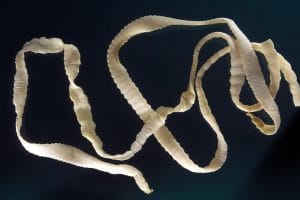
Tapeworm
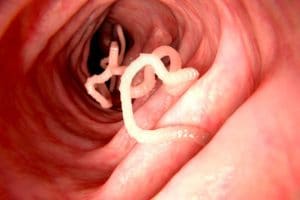
Tapeworms inside the human intestine
A well-known example of Platyhelminthes is the tapeworm, which can reside in the human intestines and grow up to six meters in length. It has a ribbon-like body with a small head-like structure at the front. The tapeworm absorbs already-digested food from its host’s intestine. These characteristics of Platyhelminthes highlight their adaptations as parasites and their reproductive strategies within the animal kingdom’s classification.
3.2.3.2 Nematodes (Roundworms)
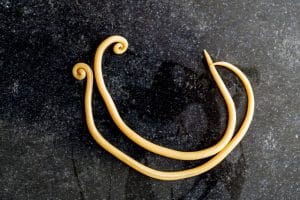
Ascaris
Nematodes, known as roundworms, have characteristic rounded and unsegmented bodies. They are predominantly small organisms, with many living as parasites within other animals, including humans. For example, Ascaris, a common roundworm, inhabits the small intestine of humans, particularly affecting children who ingest unwashed hands or unwashed fruits and vegetables. These characteristics of nematodes distinguish them within the animal kingdom classification, emphasizing their role as parasites and their impact on diverse ecosystems, notably human health.
Back to the top -Kingdom Animalia Classification and Examples
3.2.4 Annelids (Segmented Worms)
Common examples of Annelids are earthworms and Leeches.
The main characteristics of Annelids are as follows:
Annelids, named for their segmented bodies, thrive in moist environments like wet soil, freshwater, and swamps. Their bodies are soft and moist, allowing them to breathe through their skin. Annelids possess specialized excretory organs called nephridia. Earthworms, a well-known type of annelid, earn their name from their habitat in soil, where they play a vital role in enhancing soil aeration and fertility. These characteristics of annelids distinguish them within the classification of the animal kingdom, highlighting their adaptation to diverse habitats and their ecological significance, particularly in soil ecosystems.
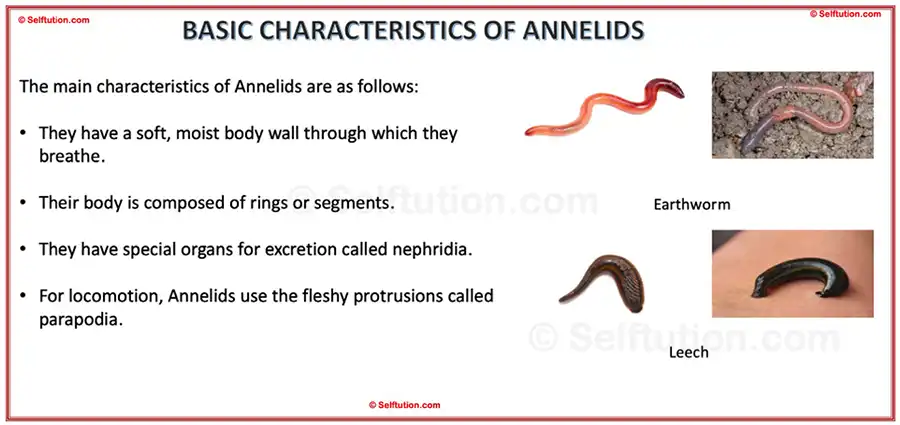
Characteristics and examples of Annelids
3.2.5 Arthropoda (Joint-footed animals)
The main characteristics of Arthropoda are as follows:
Arthropods, known as joint-footed animals, dominate the animal kingdom with their diverse characteristics. Most arthropods have bodies divided into three parts: the head, thorax (middle part), and abdomen, all encased in a tough exoskeleton made of chitin. This external covering provides protection and support for their bodies.
Within the classification of the animal kingdom, arthropods are subdivided into four main groups: Crustacea (such as crabs and shrimp), Myriapoda (including centipedes and millipedes), Insecta (like beetles, butterflies, and ants), and Arachnida (comprising spiders, scorpions, and ticks). Each subgroup exhibits unique adaptations and behaviors suited to their environments, from marine habitats to terrestrial ecosystems.
Arthropods play crucial roles in ecosystems as pollinators, predators, decomposers, and prey, contributing significantly to biodiversity and ecological balance. Their joint appendages, diverse body structures, and specialized adaptations underscore their evolutionary success and adaptability within the animal kingdom.
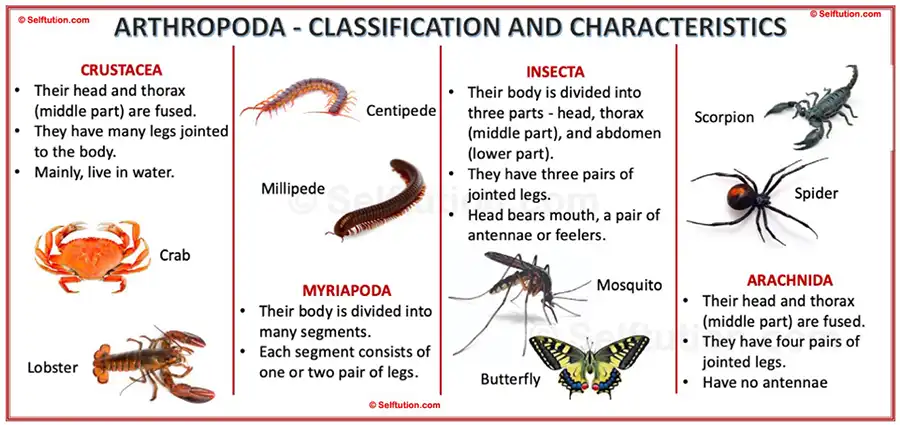
Characteristics and Examples of Arthropoda
3.2.5.1 Crustacea
Common examples of Crustacea are Crabs, shrimp, lobsters, prawns, etc.
The main characteristics of Crustacea are as follows:
Most of the Crustaceans are Aquatic, living in either marine or freshwater environments. However, few of them have adapted to life on land. For example, woodlice. The body of a Crustacean consists of three parts – head, thorax (middle part), and abdomen. But, in most of them, the head and thorax are fused as one single part. They have many leg joints in the body.
3.2.5.2 Myriapoda
Common examples of Myriapoda are centipedes, millipedes, etc.
The main characteristics of Myriapoda are as follows:
Myriapoda derived their name from the words ‘myriad’ (which means ‘countless’) and ‘poda’ (which means ‘feet’). Thus, these are animals with countless feet. Myriapoda’s body is divided into many segments. Each segment consists of one or two pairs of legs. Myriapods have a single pair of antennae and, in most cases, simple eyes. However, there are certain exceptions where they have compound eyes like insects. Myriapods mainly live on land.
3.2.5.3 Insecta
Common examples of insects are houseflies, butterflies, ants, mosquitoes, etc.
The main features/characteristics of Insecta are as follows:
Over 90% of the animal life forms on Earth are insects, with more than a million species. The body of Insecta clearly distinguishes between the head, thorax (middle part), and abdomen (lower part). The tough exoskeleton, called chitin, covers their outer body. They have three pairs of jointed legs. The head bears a mouth, a pair of antennae, or feelers. Nearly all insects give birth by laying eggs. Adult insects typically move about by walking, flying, or sometimes swimming.
3.2.5.4 Arachnida
Common examples of Arachnida are spiders, scorpions, etc.
The main characteristics of Arachnida are as follows:
There are hundreds of thousands of species of arachnids. Arachnids mainly live on land, however, some are aquatic. The body of Arachnida consists of three parts – head, thorax (middle part), and abdomen. But, in most of them, the head and thorax are fused as one single part. They have four pairs of jointed legs and, unlike Insecta, they don’t have antennae. No arachnids have wings, although some spiders can float on the wind using long strands of silk. Many arachnids use silk, either to catch prey or to help them reproduce. Arachnids give birth by laying eggs.
3.2.6 Mollusca (Soft-bodied shelled animals)
Common examples of Mollusca are snails, octopuses, and pearl oysters etc.
The main features/characteristics of Mollusca are as follows:
Mollusks, found in diverse habitats worldwide, feature soft bodies with distinct “head” and “foot” regions. Many mollusks are protected by a hard exoskeleton, aiding in defense and structural support. Movement is facilitated by a muscular foot, enabling them to navigate environments ranging from oceans to freshwater and land. Reproduction in mollusks typically involves laying eggs, ensuring the continuation of their species. Within the classification of the animal kingdom, mollusks represent a significant phylum known for their varied forms and adaptations to different ecological niches. These characteristics of Mollusca highlight their adaptability and essential roles in marine and terrestrial ecosystems.
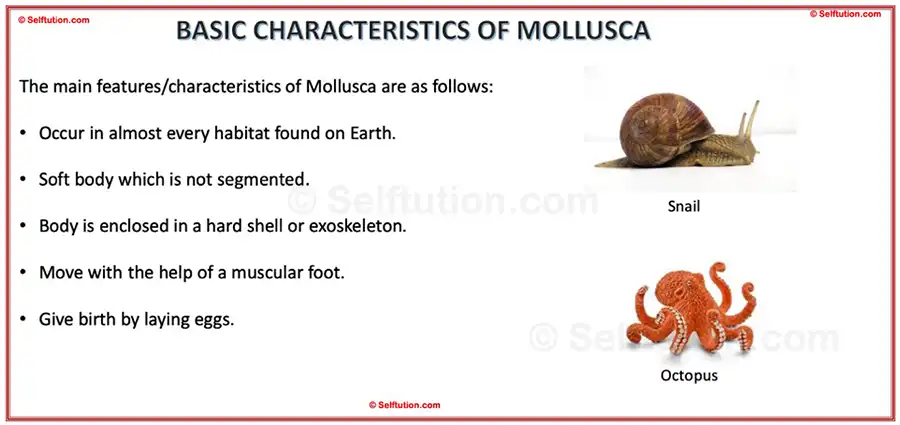
Characteristics and Examples of Mollusca
Back to the top -Kingdom Animalia Classification and Examples
3.2.7 Echinodermata (Spiny-skinned animals)
Common examples of Echinodermata are starfish, sea urchins, etc.
The main characteristics of Echinodermata are as follows:
Echinoderms, marine animals inhabiting oceans and seas, are characterized by rough, spiny bodies that exhibit radial symmetry, capable of being divided into identical halves along any plane. They move along the ocean floor using tube feet, which also aid in capturing food and attaching to surfaces. Reproduction in echinoderms typically involves laying eggs, contributing to their species’ propagation. Within the classification of the animal kingdom, Echinodermata represents a unique phylum known for its distinctive body structure and ecological roles in marine ecosystems. These characteristics of Echinodermata underscore their evolutionary adaptations and significance in maintaining biodiversity and ecological balance in oceanic environments.
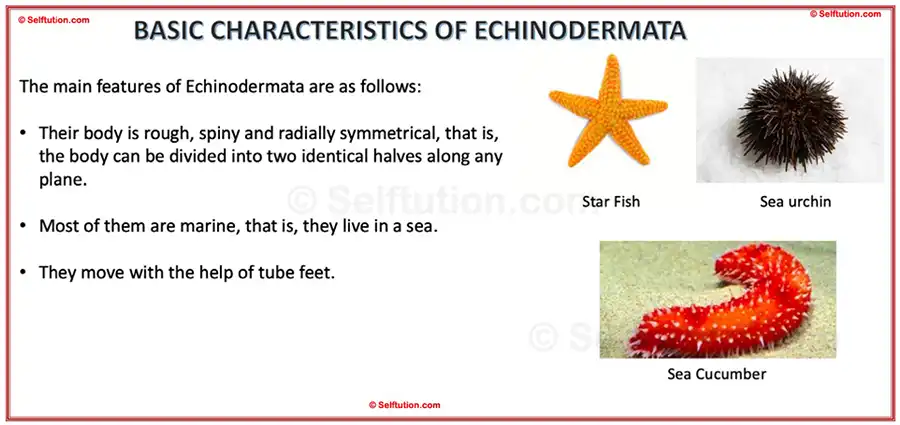
Characteristics and examples of Echinodermata
4.0 OTHER CRITERIA FOR CLASSIFICATION OF ANIMAL KINGDOM
Apart from as specified above, there are also other characteristics used for the classification of the animal kingdom. These are:
4.1 Classification and Examples of the Kingdom Animalia Based on the Temperature of Blood
Based on the temperature of blood, we classify animals into two groups: cold-blooded and warm-blooded animals. Cold-blooded animals are those whose body temperature changes with the change in the temperature of the environment. For example, frogs and toads. Warm-blooded animals are those whose body temperature remains constant with the change in the temperature of the environment. Birds and mammals are the only warm-blooded animals. For example – Humans, cats, mice, tigers, peacocks, sparrows, etc.
4.2 Classification and Examples of the Kingdom Animalia Based on Body Type
Based on body type, we can place animals in several groups, such as hollow, flat, round, porous, soft, hard, radially symmetrical, etc. Examples for each group are – hollow (hydra and sea anemones), flat (Tapeworm), round (Ascaris), porous (Sponge), soft (Frog, earthworm, snail, and octopus), hard (Cockroach, crab, and lobster), radially symmetrical (hydra, starfish and sea urchin).
4.3 Classification and Examples of the Kingdom Animalia Based on Body Covering
Based on their body covering, these animals are kept in groups, such as scales, feathers, hair, or fur, etc. Examples for each group are – scales (snakes and fishes), feathers (as in birds), hairs, or furs (as in mammals like cats, dogs, and cows).
4.4 Classification and Examples of the Kingdom Animalia Based on Mode of Reproduction
Still, another way for classification of the animal kingdom is based on the mode of reproduction. Animals reproduce both asexually as well as sexually. In asexual reproduction, only one parent (hermaphrodite – having both male and female sex organs) is involved, whereas sexual reproduction occurs between two different male and female parents. Animals like sponges, hydra, etc., prefer asexual reproduction by budding, although they can reproduce sexually as well. Meanwhile, most of the animals reproduce sexually by laying eggs (such as frogs, birds, and reptiles), and some others give birth to young ones (as in mammals).
4.5 Classification and Examples of the Kingdom Animalia Based on Mode of Nutrition
Animals are heterotrophic in nutrition, that is, they derive food from other organisms, as they cannot prepare their own food. Heterotrophic animals may be of two types – Holozoic and Parasitic.
- Holozoic animals consume whole food (animal or plant) into their body and then digest it. We call this nutrition, holozoic. Holozoic animals are of three further types –
- Herbivores – those that eat only plants. For example – horses, cows, deer, etc..
- carnivores – those that eat other animals. For example, cats, lions, hyenas, etc.
- Omnivores – those that eat both plants and animals. For example, a man.
- Parasitic animals live on other organisms (called the host) and derive nutrition in the form of pre-digested food from the host.
Back to the top -Kingdom Animalia Classification and Examples
